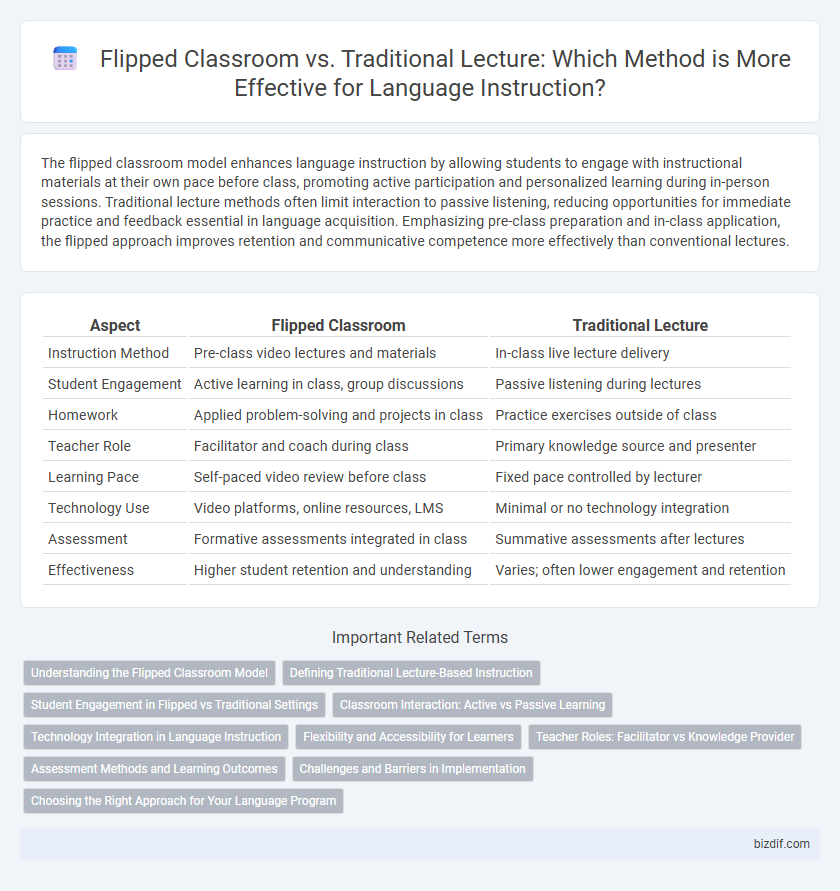The flipped classroom model enhances language instruction by allowing students to engage with instructional materials at their own pace before class, promoting active participation and personalized learning during in-person sessions. Traditional lecture methods often limit interaction to passive listening, reducing opportunities for immediate practice and feedback essential in language acquisition. Emphasizing pre-class preparation and in-class application, the flipped approach improves retention and communicative competence more effectively than conventional lectures.
Table of Comparison
| Aspect | Flipped Classroom | Traditional Lecture |
|---|---|---|
| Instruction Method | Pre-class video lectures and materials | In-class live lecture delivery |
| Student Engagement | Active learning in class, group discussions | Passive listening during lectures |
| Homework | Applied problem-solving and projects in class | Practice exercises outside of class |
| Teacher Role | Facilitator and coach during class | Primary knowledge source and presenter |
| Learning Pace | Self-paced video review before class | Fixed pace controlled by lecturer |
| Technology Use | Video platforms, online resources, LMS | Minimal or no technology integration |
| Assessment | Formative assessments integrated in class | Summative assessments after lectures |
| Effectiveness | Higher student retention and understanding | Varies; often lower engagement and retention |
Understanding the Flipped Classroom Model
The flipped classroom model transforms language instruction by reversing traditional teaching methods, where students engage with instructional content at home and practice skills through interactive activities during class. This approach enhances language comprehension and retention by promoting active learning and personalized feedback in the classroom environment. Research shows that flipped classrooms improve student engagement and language proficiency compared to conventional lecture-based instruction.
Defining Traditional Lecture-Based Instruction
Traditional lecture-based instruction centers on the teacher delivering content directly to students through oral presentations, often accompanied by visual aids like slides or a chalkboard. This method emphasizes passive learning where students listen and take notes, with minimal interaction or collaboration during class. The primary goal is to transmit knowledge efficiently, relying heavily on memorization and recall for assessment.
Student Engagement in Flipped vs Traditional Settings
Student engagement in flipped classroom settings significantly surpasses that in traditional lectures due to active learning strategies like group discussions, problem-solving, and peer collaboration. Research on language instruction highlights increased participation, motivation, and retention when learners interact with instructional materials before class and apply knowledge during in-person sessions. This approach cultivates deeper cognitive processing and higher-order thinking skills, transforming passive listeners into active, engaged language learners.
Classroom Interaction: Active vs Passive Learning
Flipped Classroom transforms classroom interaction by promoting active learning where students engage in discussions, problem-solving, and peer collaboration during class time. Traditional Lecture often results in passive learning, with students primarily listening and taking notes, limiting real-time interaction and immediate feedback. Active participation in Flipped Classroom models enhances language acquisition through practical application and continuous engagement.
Technology Integration in Language Instruction
Technology integration in language instruction transforms the flipped classroom by enabling students to access multimedia resources and interactive exercises before class, promoting active participation during in-person sessions. Traditional lectures rely heavily on direct teacher exposition, limiting opportunities for personalized technology use and real-time feedback. The flipped model leverages digital tools such as language apps, video lessons, and online forums, enhancing learner engagement and improving proficiency through continuous practice outside the classroom.
Flexibility and Accessibility for Learners
Flipped Classroom models enhance flexibility by allowing learners to access instructional content anytime through digital platforms, accommodating diverse schedules and learning paces. Unlike Traditional Lectures that require fixed class times, these models provide greater accessibility for students balancing work, family, or different time zones. This approach promotes personalized learning experiences, fostering improved engagement and comprehension within language instruction environments.
Teacher Roles: Facilitator vs Knowledge Provider
In a flipped classroom, the teacher acts as a facilitator, guiding students through interactive activities and personalized support, fostering critical thinking and active learning. In contrast, the traditional lecture positions the teacher primarily as a knowledge provider, delivering content through direct instruction with limited student engagement. This shift enhances student autonomy and improves comprehension by transforming the teacher's role from information dispenser to learning coach.
Assessment Methods and Learning Outcomes
Flipped Classroom assessment methods emphasize formative evaluations such as quizzes and peer assessments, promoting active learning and immediate feedback, which enhances student engagement and comprehension. Traditional Lecture assessments often rely on summative exams focused on content recall, potentially limiting deep understanding and critical thinking. Studies show flipped classrooms improve learning outcomes by fostering higher-order cognitive skills and better retention compared to traditional lecture formats.
Challenges and Barriers in Implementation
Implementing a flipped classroom model faces challenges such as student resistance due to unfamiliarity with active learning and the need for reliable access to digital resources outside class. Traditional lectures often benefit from established routines, but they limit interactive engagement and personalized feedback. Educators must overcome barriers including time constraints for content creation, technological proficiency, and ensuring equitable student participation in flipped environments.
Choosing the Right Approach for Your Language Program
Choosing between a flipped classroom and traditional lecture depends on the specific goals and learner preferences of your language program. Flipped classrooms encourage active participation and personalized pacing by assigning video lessons for homework, which leads to increased in-class practice and interaction. Traditional lectures offer structured, instructor-led explanations suitable for foundational grammar and vocabulary introduction but may limit student engagement and immediate feedback.
Flipped Classroom vs Traditional Lecture Infographic

 bizdif.com
bizdif.com